Our verdict
- Top pick in best running shoes for supination
- Top pick in best running shoes for underpronation
Pros
- Fantastic new upper
- Improved overall comfort
- Grippier outsole without cutouts
- Durability enhancements
- Excellent weight/cushioning ratio
- Supreme stability
- Works at every pace and distance
- Exceptional performance without a carbon plate
- Exceptional performance without a carbon plate
Cons
- Slight weight gain
- Fit remains tight
- Minimal tongue padding
- Energy return is not on par with the price
Audience verdict
- Top 23% in road running shoes
- Top 23% in neutral running shoes
- Top 6% most popular running shoes
Comparison
The most similar running shoes compared
+ + Add a shoe | |||||
|---|---|---|---|---|---|
| Audience score | 90 Great! | 91 Superb! | 89 Great! | 89 Great! | |
| Price | £210 | £170 | £180 | £160 | |
| Pace | Daily runningTempo | Daily running | Daily running | Daily running | |
| Shock absorption | Moderate | High | High | High | |
| Energy return | High | Moderate | Low | Moderate | |
| Traction | High | High | - | High | |
| Arch support | Neutral | Neutral | Neutral | Neutral | |
| Weight lab Weight brand | 8.9 oz / 252g 8.8 oz / 250g | 10.3 oz / 291g 10.3 oz / 292g | 10.8 oz / 305g 10.9 oz / 309g | 9.9 oz / 282g 10 oz / 283g | |
| Drop lab Drop brand | 8.2 mm 8.0 mm | 9.6 mm 8.0 mm | 6.6 mm 6.0 mm | 8.7 mm 5.0 mm | |
| Strike pattern | HeelMid/forefoot | HeelMid/forefoot | Mid/forefoot | HeelMid/forefoot | |
| Size | True to size | True to size | True to size | True to size | |
| Midsole softness | Soft | Soft | Soft | Soft | |
| Difference in midsole softness in cold | Small | Big | Small | Normal | |
| Toebox durability | Good | Decent | Decent | Decent | |
| Heel padding durability | Good | Decent | Good | Good | |
| Outsole durability | Good | Decent | Decent | Good | |
| Breathability | Breathable | Moderate | Breathable | Breathable | |
| Width / fit | Medium | Medium | Medium | Medium | |
| Toebox width | Medium | Medium | Medium | Narrow | |
| Stiffness | Stiff | Stiff | Stiff | Stiff | |
| Torsional rigidity | Stiff | Stiff | Stiff | Stiff | |
| Heel counter stiffness | Moderate | Moderate | Moderate | Stiff | |
| Rocker | ✓ | ✓ | ✓ | ✗ | |
| Heel lab Heel brand | 42.8 mm 45.0 mm | 42.9 mm 47.0 mm | 42.3 mm 47.0 mm | 39.3 mm 39.0 mm | |
| Forefoot lab Forefoot brand | 34.6 mm 37.0 mm | 33.3 mm 39.0 mm | 35.7 mm 41.0 mm | 30.6 mm 34.0 mm | |
| Widths available | NormalWide | Normal | Normal | NormalWide | |
| Orthotic friendly | ✓ | ✓ | ✓ | ✓ | |
| Season | SummerAll seasons | All seasons | SummerAll seasons | SummerAll seasons | |
| Removable insole | ✓ | ✓ | ✓ | ✓ | |
| Ranking | #81 Top 22% | #35 Top 10% | #110 Top 30% | #121 Top 33% | |
| Popularity | #22 Top 6% | #136 Top 36% | #8 Top 3% | #117 Top 31% |
Who should buy
We put the ASICS Superblast 2 through all kind of tests to determine if it truly is the ultimate Swiss Army knife of running shoes. Our findings confirmed that it excels for:
- Fans of the original Superblast, because ASICS has enhanced almost every aspect from top to bottom without significant compromises.
- Runners who simply want to have the best products on the market. This is an almost unparalleled training shoe. Period.
- Marathoners looking for a plateless yet bouncy super trainer—it's ideal for tackling long runs at slower and faster paces.
- Those desiring a single running shoe versatile enough to handle all distances and speeds, from daily training to competition.
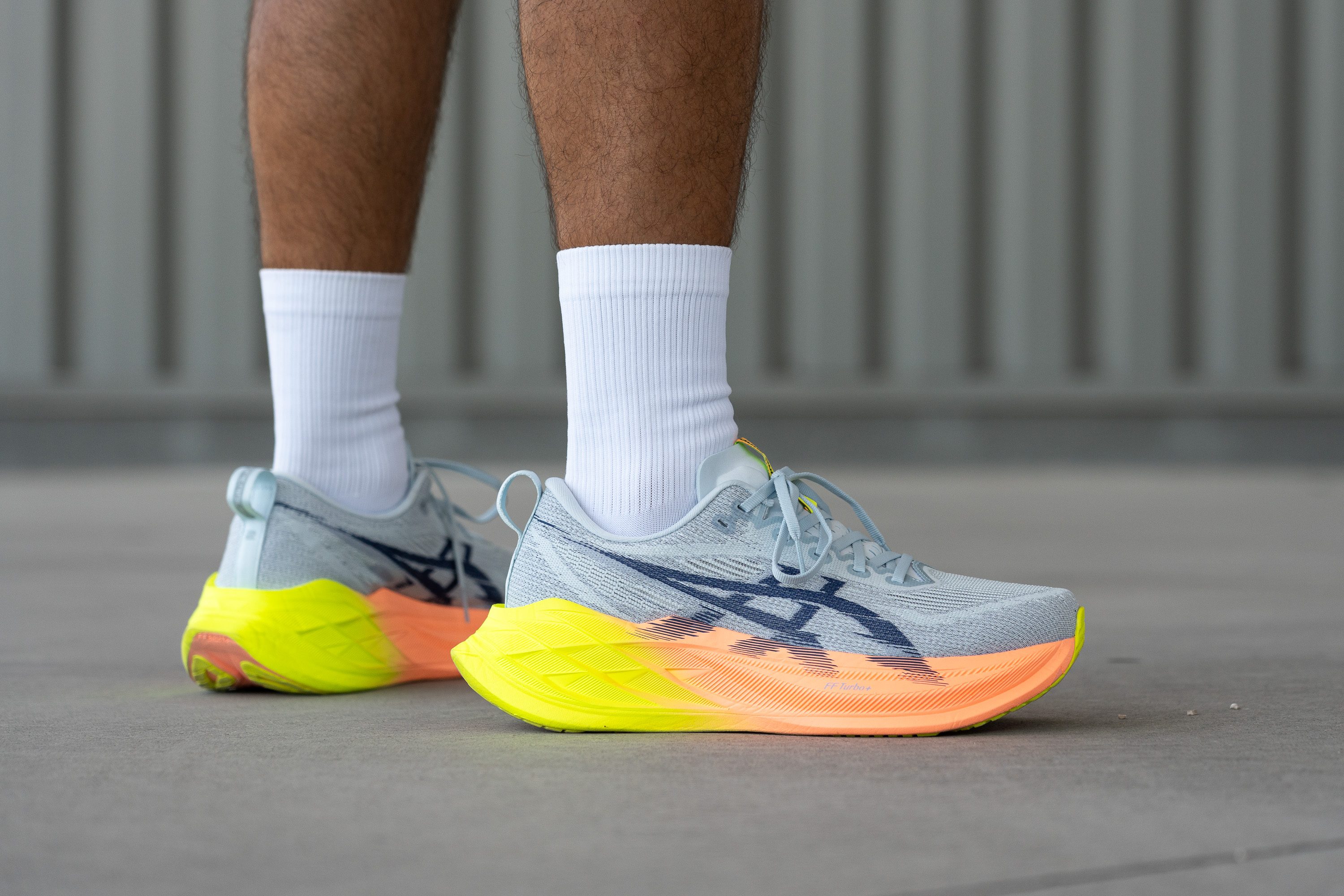
Who should NOT buy
We really liked the Superblast 2, but we do not recommend it for budget-conscious runners due to its steep £200 price tag.
For those seeking similar high-performance features at a lower cost, we suggest the Saucony Endorphin Speed 4 or the Hoka Mach X, both offering excellent superfoam technology at a slightly lower price. Additionally, the ASICS Novablast 4 delivers similar cushioning (with reduced energy return) for £60 less.
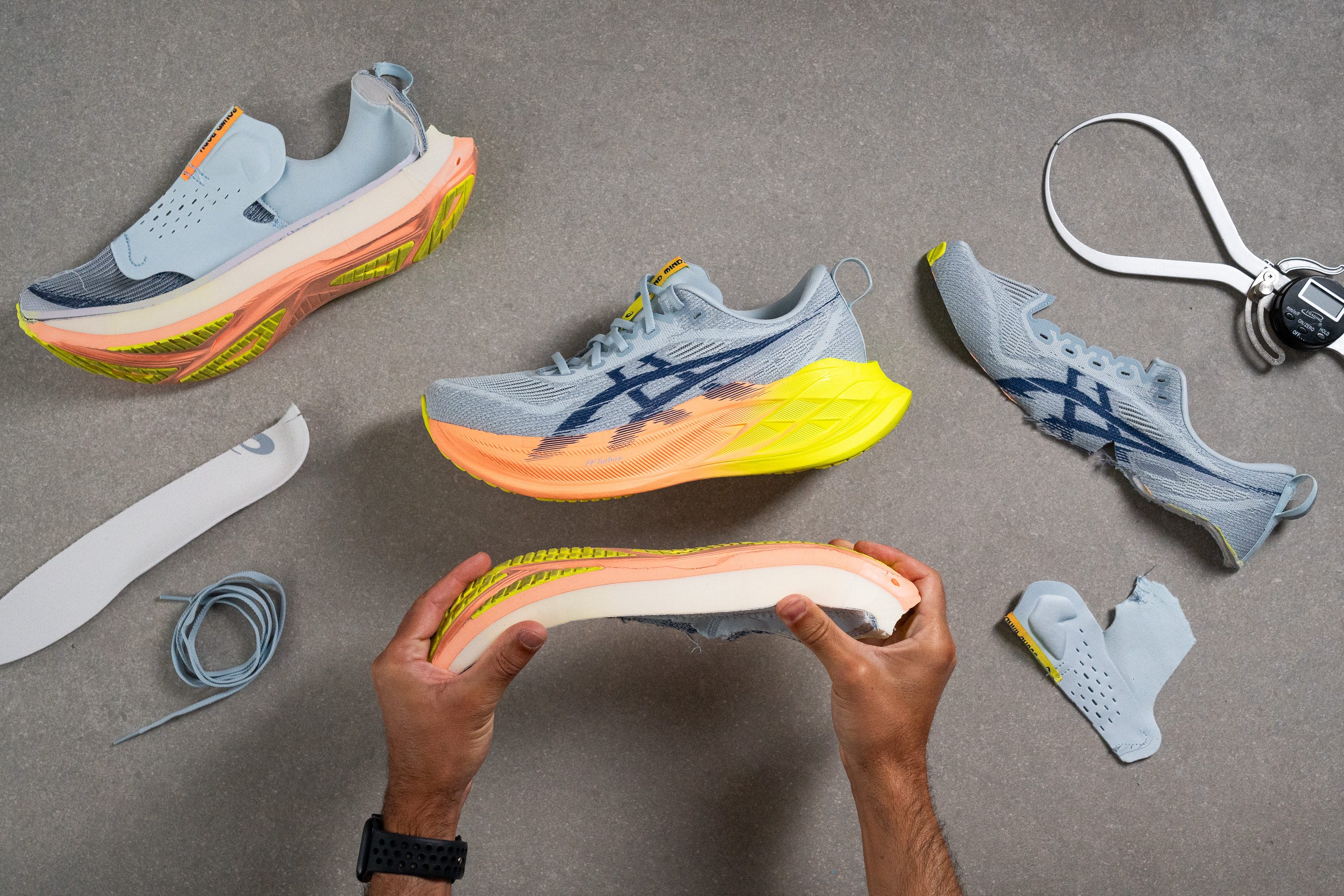
We also think that runners with wide feet should avoid the Superblast 2, as it provides a performance fit that is far from spacious. From our testing here in the lab, we've gathered that the On Cloudmonster Hyper offers a much more accommodating fit, making it a superior choice for those needing extra room.
Cushioning
Shock absorption
The ASICS Superblast 2 is one of the rare shoes we've tested—out of hundreds—that delivers stronger shock absorption in the forefoot than in the heel. But how can that be?
It comes down to the wide forefoot and towering stack, which offers outstanding joint and muscle protection. We measured 130 SA in the heel and an impressive 138 SA upfront.

| Superblast 2 | 130 SA |
| Average | 129 SA |
Energy return
In terms of energy return, we have to admit we expected a bit more from the Superblast 2. While it still scores above average and offers plenty of bounce for most runners, we were hoping for a result above 70%, not the 65.4% we recorded. Especially at its high price point.
The reason it doesn't hit 70% lies in its design. Placing the EVA-based FF Blast+ ECO underneath the FF Turbo+ layer tones down the bounce—though it does help boost durability.
| Superblast 2 | 65.4% |
| Average | 58.5% |
Heel stack
We often describe the Superblast series as a daily trainer on steroids, and the second iteration truly lives up to this description. It boasts a massive stack height of 42.8 mm in the heel, positioning it among the tallest shoes we've ever evaluated—only trailing the colossal Adidas Adizero Prime X 2 Strung.
Despite its massive over-40-mm stack and being classified as a super trainer, the Superblast 2 maintains remarkable stability and comfort. For this reason, it's our top recommendation for runners seeking maximal cushioning in a versatile format, without the inclusion of rigid carbon plates.
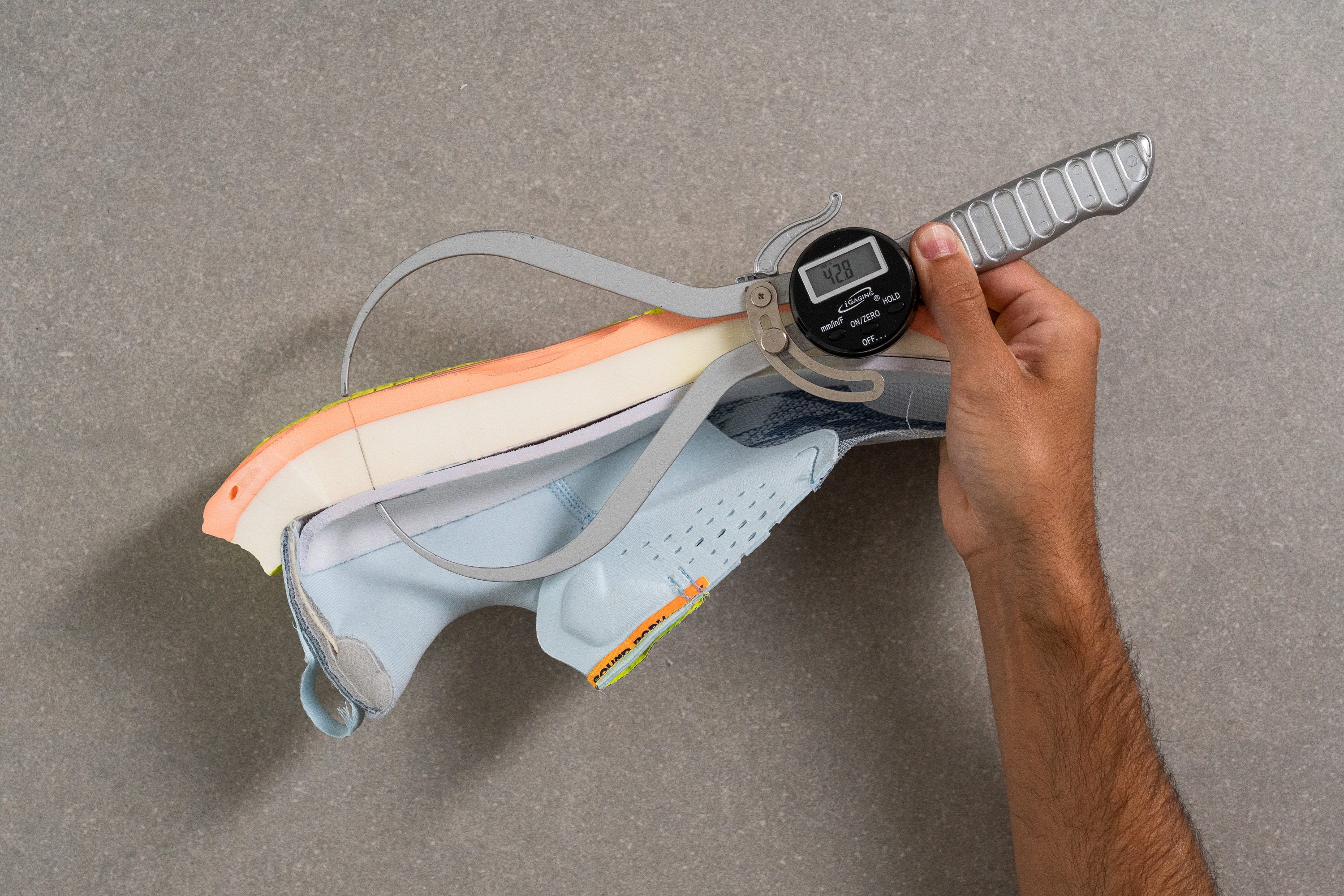
| Superblast 2 | 42.8 mm |
| Average | 34.8 mm |
Forefoot stack
Unsurprisingly, the forefoot of the Superblast 2 almost mirrors the first version. Our callipers measured 34.8 mm in the original, and this update showed a minimal decrease, measuring 34.6 mm.
Of course, this is higher than the heel measurements of nearly any other running shoe on the market. The SB2 it's truly all about cushioning—plenty aaand then some more!

| Superblast 2 | 34.6 mm |
| Average | 26.2 mm |
Drop
In our lab, we highly value accurate heel-to-toe drop measurements, a crucial factor since many brands often have discrepancies that can confuse runners and lead to injuries. The ASICS Superblast 2 is advertised with an 8 mm drop, and our detailed measurements verified this, revealing an almost exact drop of 8.2 mm—only a 0.2 mm variance.
By the way, this picture perfectly showcases the Superblast 2's dual foam configuration, highlighting the PEBA-based FF Turbo+ (top) and EVA-based FF Blast+ ECO (bottom).

| Superblast 2 | 8.2 mm |
| Average | 8.6 mm |
Midsole softness
The standout feature of the Superblast 2 is undoubtedly its superb midsole—this is where the magic truly happens. Our testing revealed that ASICS has invested heavily here, placing a big slab of their just-released superfoam, FF Turbo+, directly beneath your feet. And under this layer, there's another noteworthy upgrade: FF Blast+ ECO has replaced the standard FF Blast+.
Switching from FF Turbo to FF Turbo+ might seem subtle, but it marks a significant improvement. The previous foam, while bouncy, was non very compliant and also required a noticeable break-in period. These issues are resolved with the new FF Turbo+, which provides a softer, more comfortable feel underfoot with a softness score of 18.5 HA.
This supercritical PEBA blend is comparable to Nike's ZoomX, matching its performance, placing it among the elite foams in the market.

| Superblast 2 | 18.3 HA |
| Average | 20.4 HA |
Secondary foam softness
The secondary layer of FF Blast+ ECO in the Superblast 2 serves dual purposes—it shields the more delicate FF Turbo+ from external damage and adds a touch of firmness to the ride at 20.5 HA, enhancing stability.

While it doesn't match the performance pinnacle of the top-tier FF Turbo+, the FF Blast+ ECO is a training-oriented blend, combining EVA and Olefin, tailored not for competition but for durability and daily training. Nevertheless, it shines as one of the most responsive EVA foams available, also used in other high-end ASICS models like the luxuriously cushioned Nimbus 26.
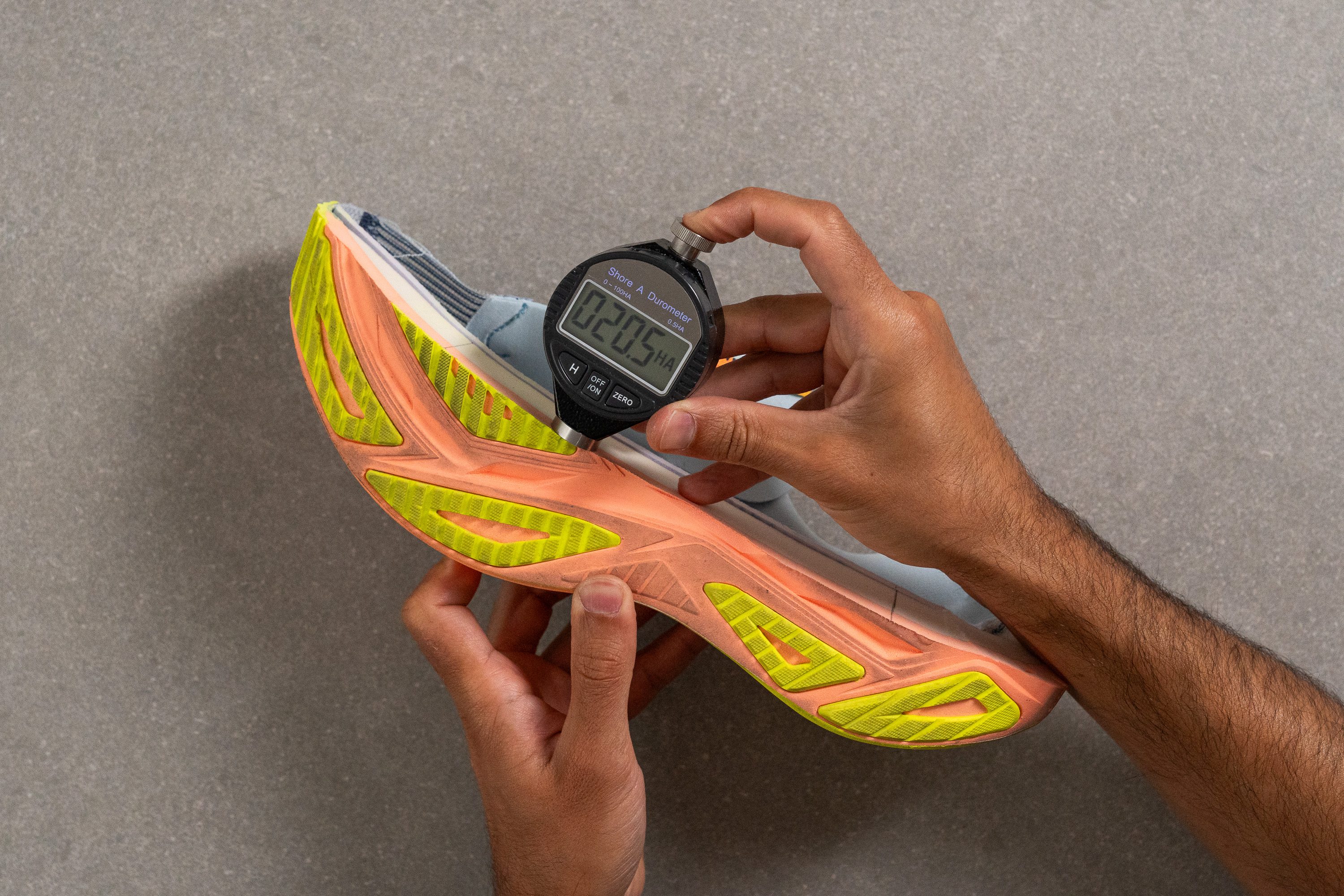
| Superblast 2 | 20.6 HA |
| Average | 22.8 HA |
Rocker
The Superblast 2 retains the successful geometry of its predecessor, incorporating a late toe rocker and a substantial heel bevel to ease the run for heel strikers.
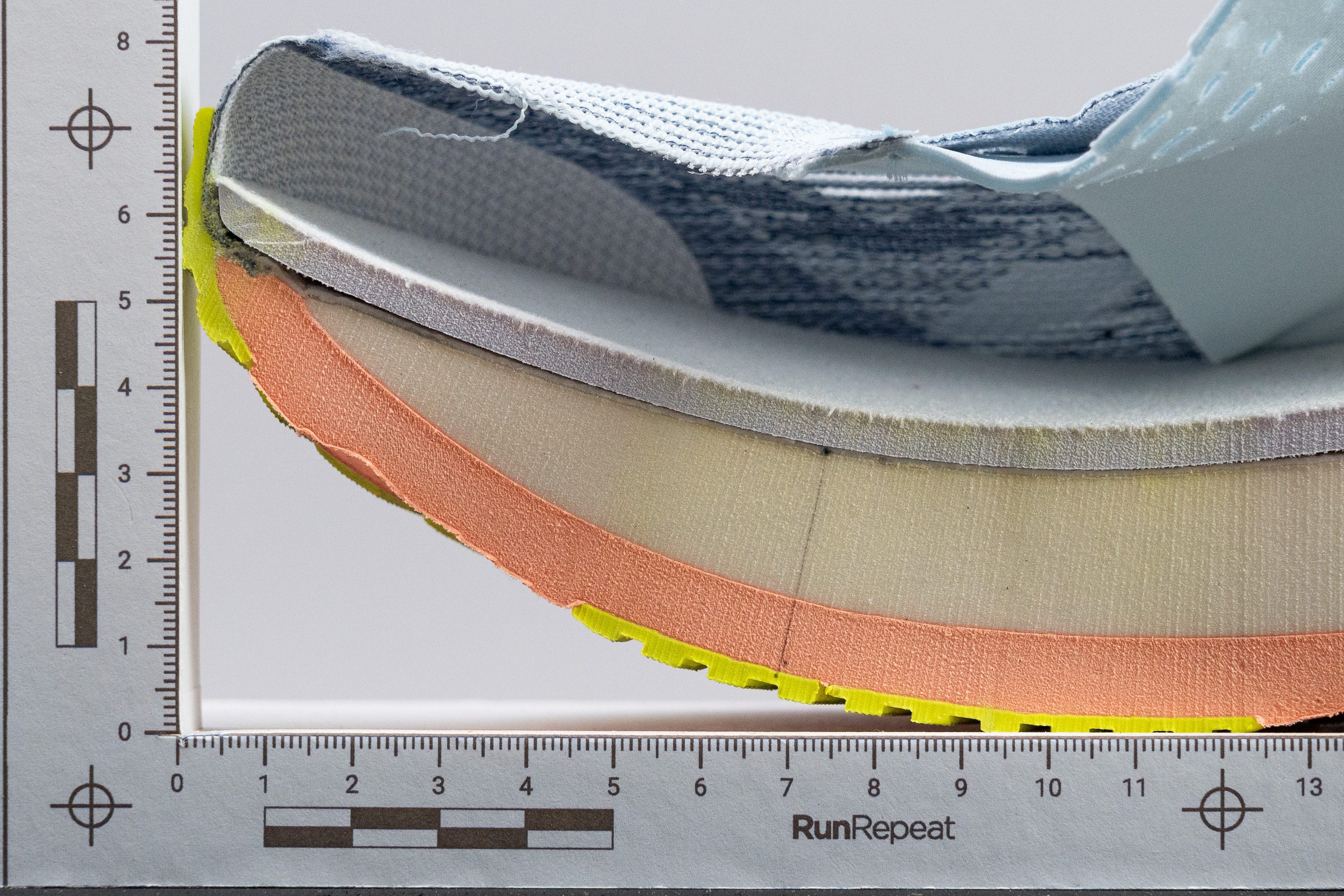
So, how does it feel? Essentially, it functions like a more dynamic daily trainer, and it's not quite as ultra-rockered as models like the Hoka Cielo X1. For us, that's a positive aspect in terms of versatility—the forefoot is sufficiently snappy, and the transitions are smooth, particularly noticeable when picking up the pace. At the end of the day, if it works well, there's no need for changes!

Size and fit
Size
ASICS Superblast 2 fits true to size (320 votes).
Internal length
| Superblast 2 | 270.4 mm |
| Average | 269.5 mm |
Width / Fit
The Superblast 2 continues to deliver what we describe as a performance fit, striking a balance between the spaciousness of a daily trainer and the snugness of a competition shoe.
To precisely measure the toebox, we created a gel mould of the Superblast 2's interiors. Measuring 94.7 mm at its widest point, we found the upper may feel a bit snug for male runners with wide feet, especially since sizing up doesn’t fully resolve the issue. However, for those who prefer a snugger fit, it’s amazing.
Women, on the other hand, will find a roomier fit, as the Superblast 2 is a unisex shoe built on a men’s last. This results in a D width for everyone, which corresponds to a women’s wide size in most other running shoes.

| Superblast 2 | 94.7 mm |
| Average | 95.1 mm |
Toebox width
In our view, the v2 left us wishing for a roomier toebox. However, we found that ASICS retained the same last, maintaining nearly identical dimensions and a slightly tapered toebox at 72.3 mm.

| Superblast 2 | 72.3 mm |
| Average | 73.3 mm |
Toebox height
The volume in the toebox is well-balanced at 27.7 mm, leaving no issues at all. In our view, the woven material from ASICS stands out for its quality—a significant improvement over the first version, which featured a more racing-inspired material.
Overall, if we had to sum up the fit of the Superblast 2, we’d say it’s incredibly similar to its predecessor, but feels like a step forward for most runners. In other words, it now feels much more aligned with its price.

| Superblast 2 | 27.7 mm |
| Average | 27.1 mm |
Traction / Grip
Traction test
ASICS may charge a premium for this shoe, but it fully earns it at least when it comes to grip. We tested it under wet conditions using our lab protocol and recorded an impressive score of 0.83.
That puts it deep into stellar territory, delivering all-weather traction with a confidence-loaded bite on slick pavement. And of course, grip on dry roads feels awesome. The ASICSGRIP rubber once again proves it’s one of the most reliable high-performance compounds on the market, giving this outsole a clear edge over most daily trainers.
| Superblast 2 | 0.83 |
| Average | 0.48 |
Outsole design
The original Superblast's outsole was often criticised by those who run on dirt roads for being a real pebble-catcher due to its small cutouts. ASICS took note and addressed this issue by eliminating the gaps that trapped stones, much to our satisfaction, and also saving us precious time after every run.
The rubber coverage is solid given the shoe's lightweight design. And there's another significant upgrade—ASICS switched from their mid-tier AHARPLUS rubber to its premium compound named ASICSGRIP.
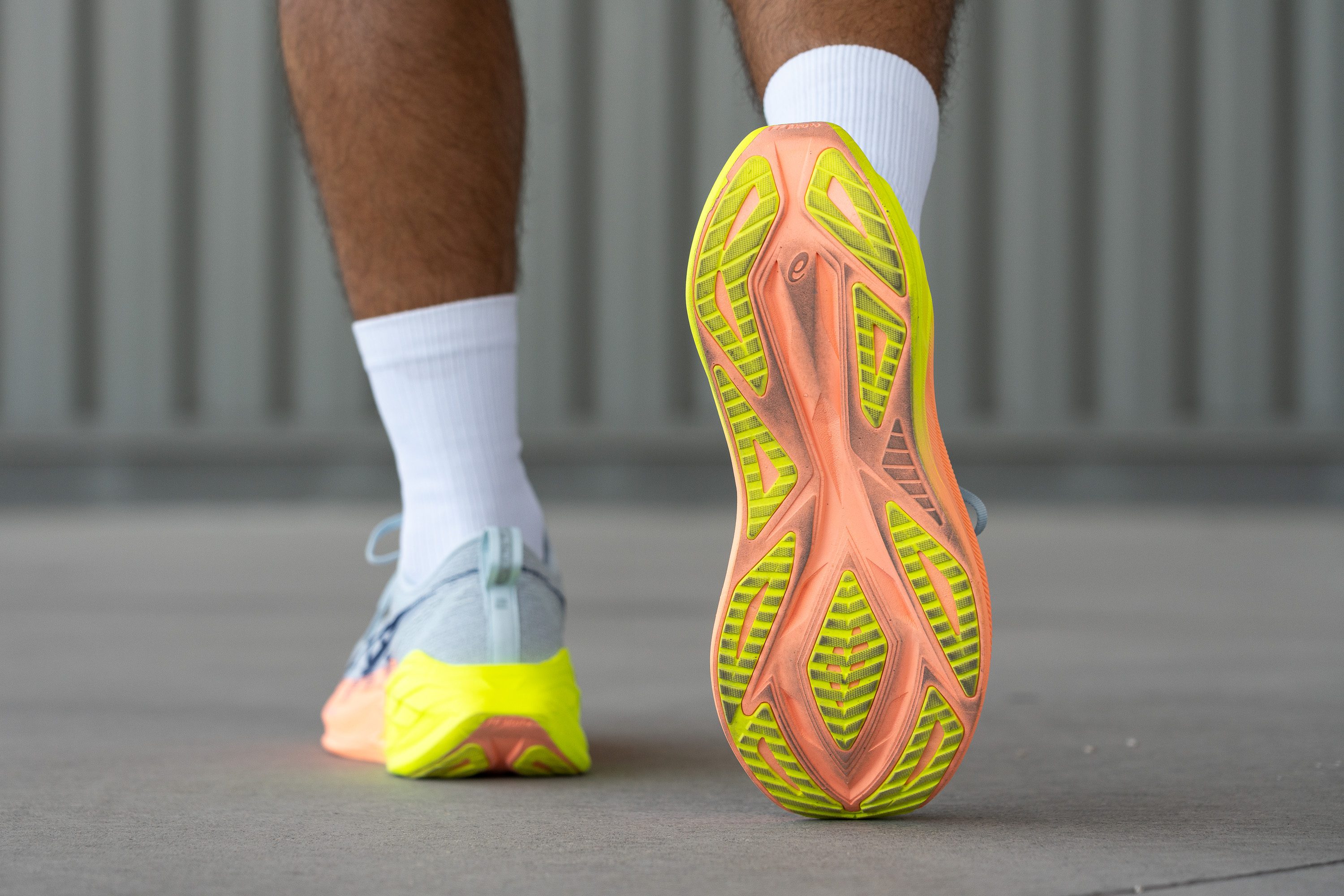
Flexibility / Stiffness
The lack of a plate in the Superblast 2 brings notable advantages for daily running—the most significant being its comfort. Despite its responsive nature, it only registered 18.4N in our 30-degree bend test, which is lower than many modern daily trainers.
This tells us that although it excels in speed and tempo training, it's also incredibly versatile across slower paces. Hence, we are big fans of this plateless design, finding it particularly beneficial for runners who suffer from stiffness-related issues, like Morton's neuroma or stress fractures.
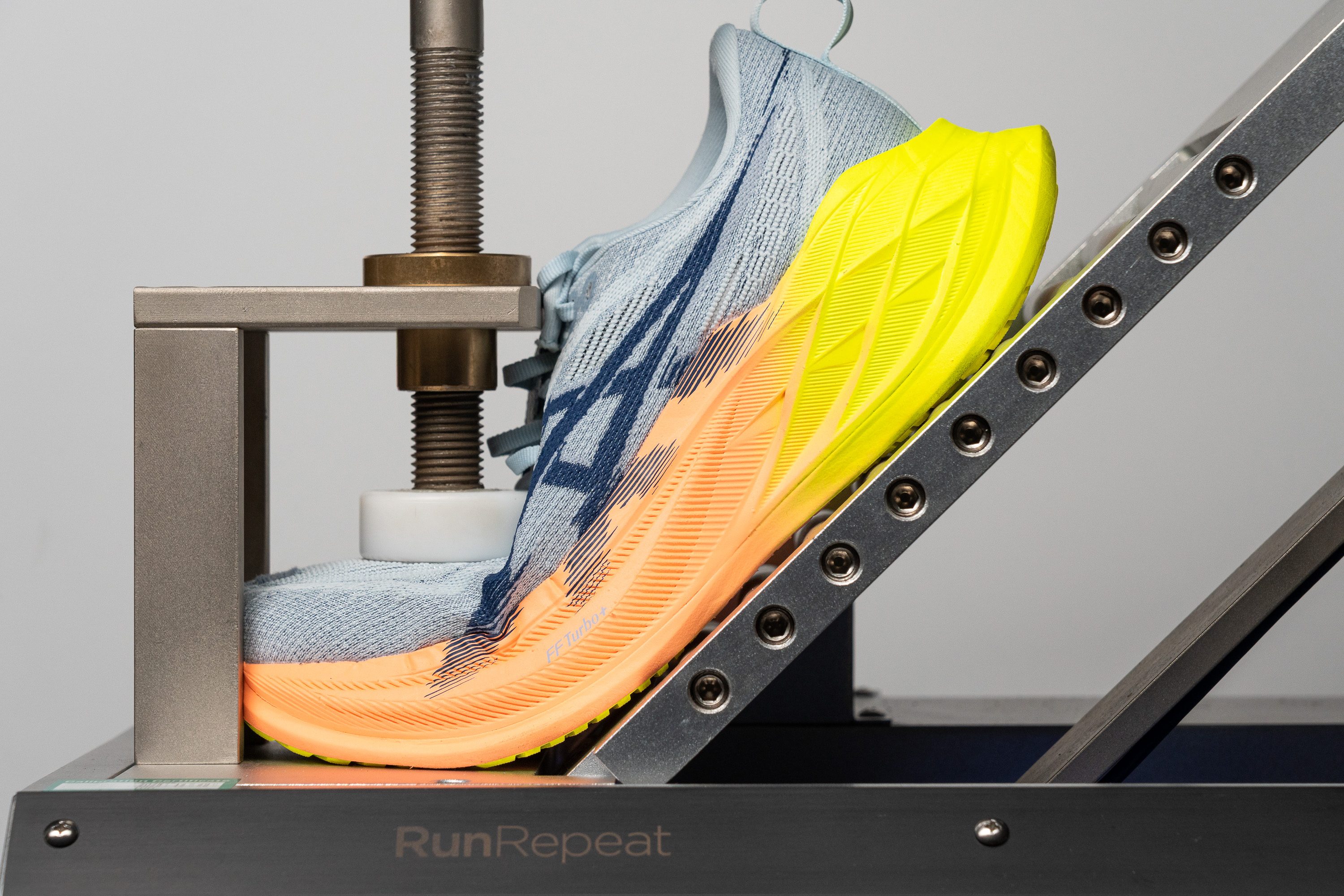
| Superblast 2 | 18.4N |
| Average | 15.3N |
Stiffness in cold (%)
We exposed the shoe to cold-weather simulations by placing it in the freezer for 20 minutes before performing the 90-degree bend test for a second time. This experiment reinforced the consistent performance of the PEBA-based foam, as we recorded only a minimal 14.2% increase in stiffness.
| Superblast 2 | 14% |
| Average | 33% |
Weight
The Superblast 2 could have scored a perfect 10/10 as an upgrade from its predecessor, but there's a slight increase in weight from 8.6 oz (244g) to 8.9 oz (252g), which is still superb for its size. While a 0.3 oz increase is barely noticeable—even to the most seasoned runners or testers—it's still an uptick.
We believe ASICS made a strategic decision here. They realised the numerous enhancements in this update meant a minor increase in weight wouldn't be a dealbreaker for anyone. And this allows them to trim the weight in the v3 without needing to improve everything else again—plus, it enabled them to enhance the upper, making it more comfortable and durable. A clever strategy, in our view.
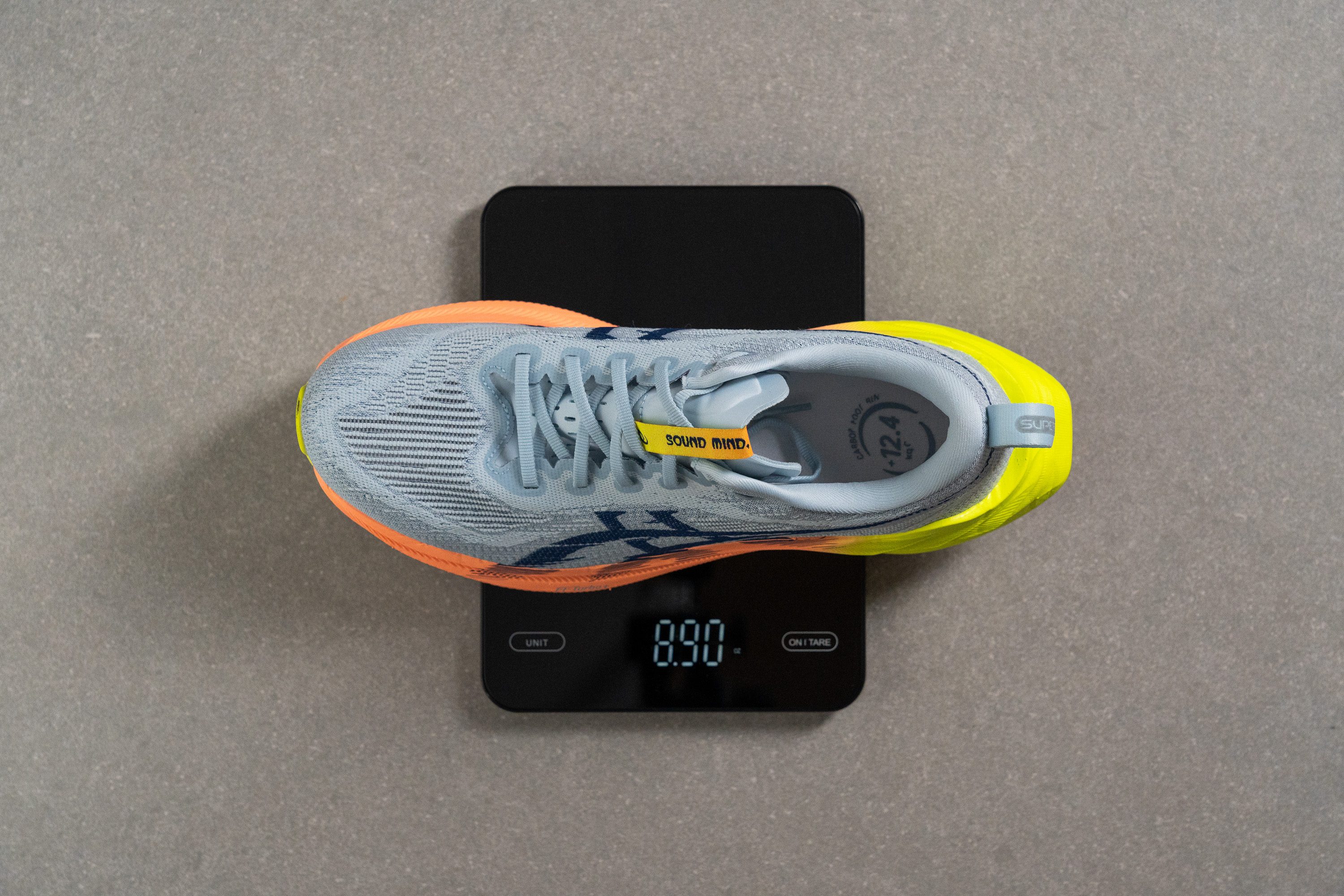
| Superblast 2 | 8.9 oz (252g) |
| Average | 9.3 oz (264g) |
Breathability
For us, the weakest point of the original Superblast was its upper—it felt scratchy and lacked ventilation, scoring just 3 out of 5 in our breathability tests. ASICS clearly took this feedback to heart because they've executed a really positive overhaul.
When we connected the Superblast 2 to our smoke-pumping machine, we observed a remarkable improvement that earned it a perfect score—5 out of 5.
Yet ASICS didn't opt for the easy route by using a simple, well-ventilated mesh throughout. Instead, they engineered the upper with varying densities and patterns, adding structure in the lower part and sides for stability while enhancing airflow in the toebox.
We were particularly intrigued by the toebox area, which impressed us at first glance. Thus, we decided to examine it under a microscope and were simply amazed.

This upper is among the most impressive we've ever evaluated here in our lab.
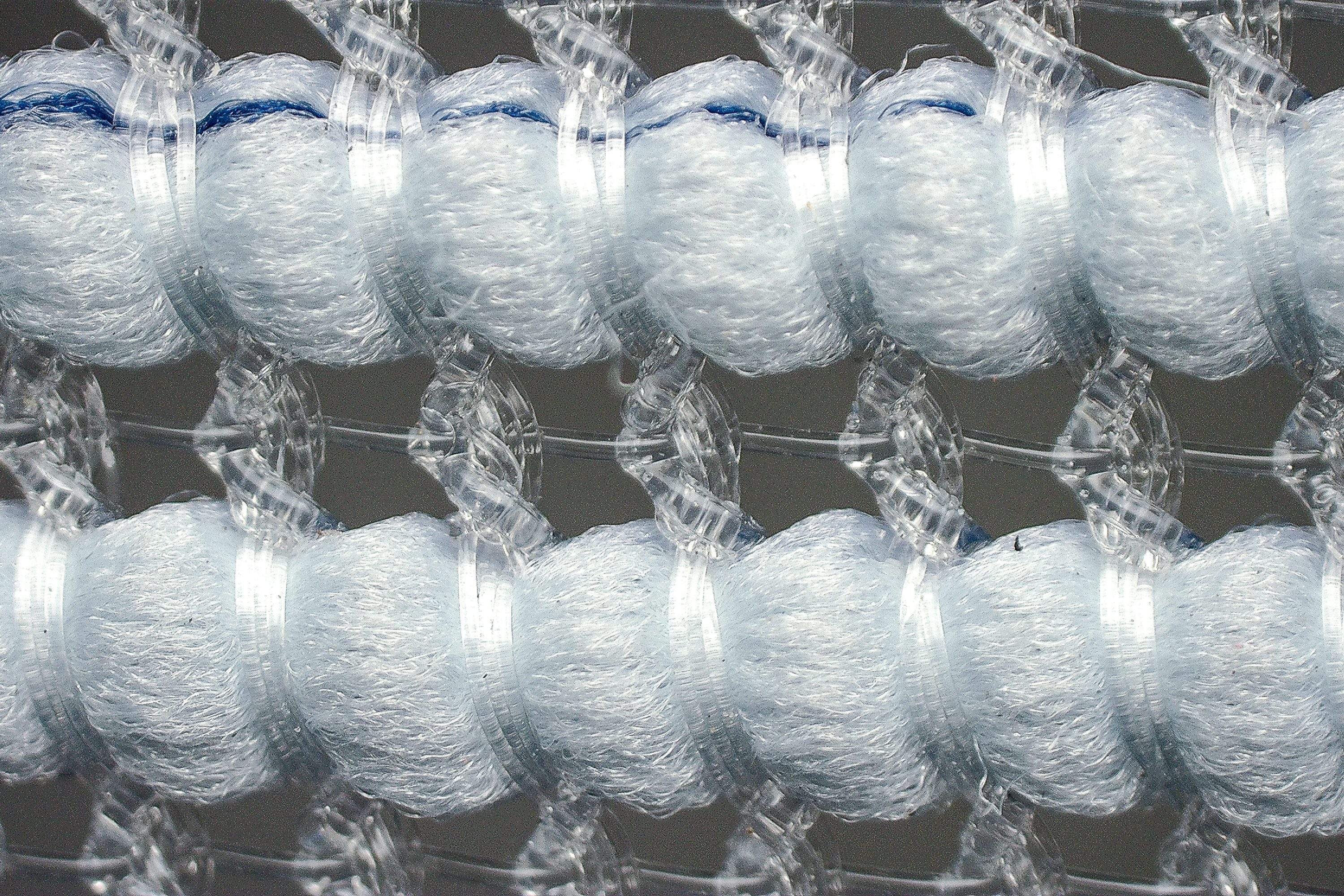
The precision is extraordinary—not only is each part thoughtfully designed and strategically placed, but it also cleverly combines thicker knit with razor-thin yarns for added durability and structure.
We also appreciated the soft interior of most of the upper, although the toebox is a bit rougher as it lacks the softer fabric to maintain breathability. For this reason, we wouldn't recommend going sockless in the Superblast 2.
| Superblast 2 | 5 |
| Average | 3.7 |
Stability
Lateral stability test
One of the hallmarks of the original Superblast was its remarkably stable performance despite its significant stack height. Version 2 maintains this exceptional support, incorporating midsole sidewalls and sole flares all around with just minor tweaks from v1.
But, how does the SB2 maintain such awesome stability with a softer underfoot foam? It's all thanks to the new enhanced upper.
To offset the softer FF Turbo+ foam's reduced support, ASICS has fortified the structure of the upper—making it more robust and better at securing the foot in place compared to the more flexible, competition-like upper of the OG Superblast. And this subtle yet significant modification makes a world of difference.
Torsional rigidity
The Superblast 2 still doesn't include a nylon or carbon plate, a choice that caused a lot of debate online when the v1 came out back in 2022. However, we always loved this because it makes the shoe stand out from the many other super trainers on the market.
Nonetheless, despite lacking a plate, the Superblast 2 is not a flexible shoe by any means—quite the contrary. Its massive stack height makes it extremely rigid, earning a max score in our twist resistance test, a 5 out of 5.
| Superblast 2 | 5 |
| Average | 3.5 |
Heel counter stiffness
We then examined the heel counter area and encountered a surprisingly moderate resistance when attempting to bend it—why the surprise?
Typically, brands aiming to enhance stability opt for an ultra-stiff heel counter, often at the expense of comfort. In contrast, ASICS has chosen a more balanced approach with a moderately firm heel counter that still maintains comfort. We appreciate this, especially considering that in our view, the ideal use for this shoe is long runs, where comfort is absolutely key.
| Superblast 2 | 3 |
| Average | 2.9 |
Midsole width - forefoot
The term "sole flare" has recently become a buzzword in the realm of running shoe design, and the Superblast 2 adopts this feature for the second time in a row, offering a wide 118.8 mm in the forefoot.
Sole flare in a running shoe happens when the midsole extends way beyond the upper, creating a wider landing platform. This feature, especially when paired with a somewhat narrow upper, offers an excellent base that is particularly advantageous for midfoot and forefoot strikers, improving stability.
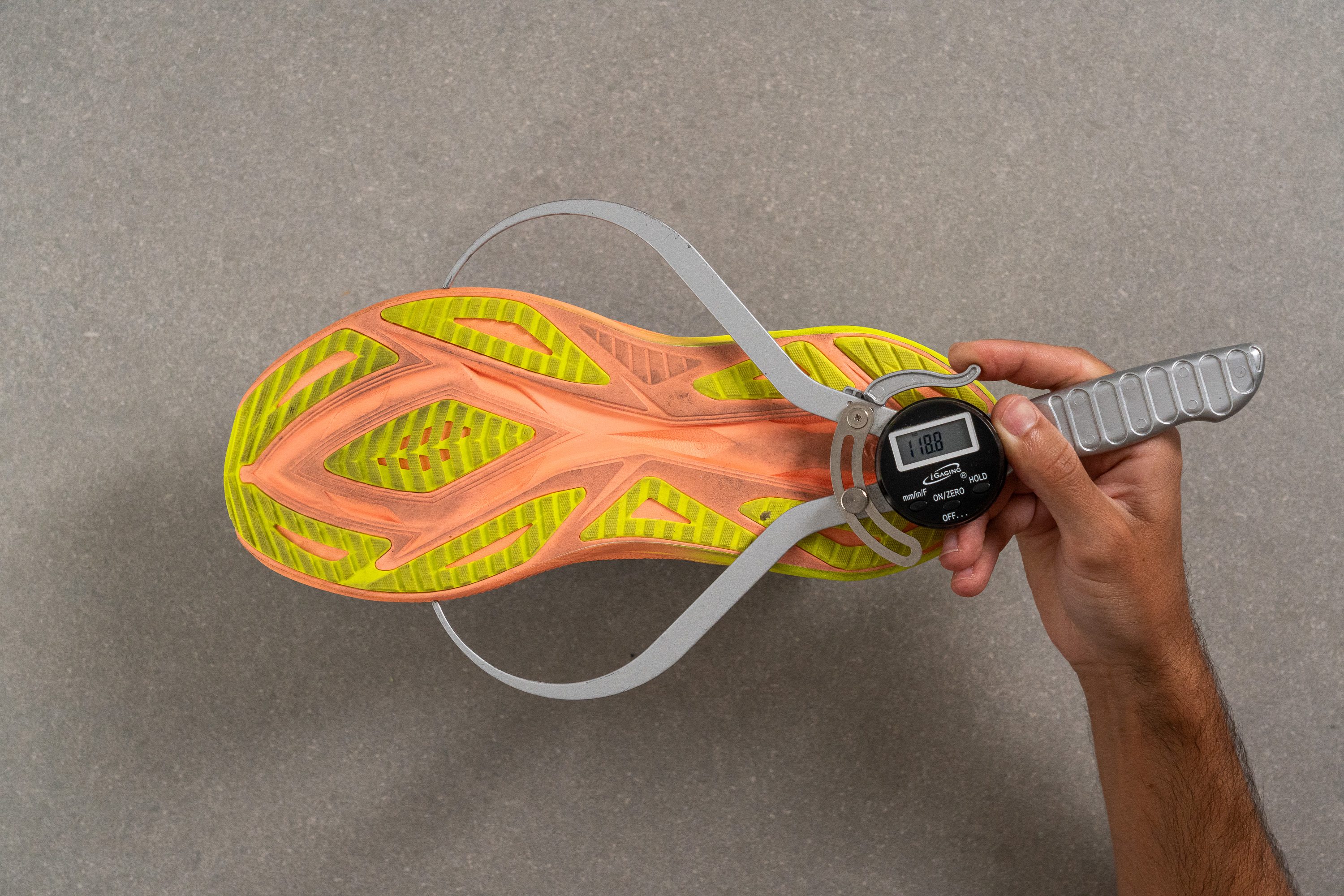
| Superblast 2 | 118.8 mm |
| Average | 114.4 mm |
Midsole width - heel
The heel on the Superblast 2 is broader than most, now measuring an impressive 97.6 mm—1 mm wider than its predecessor.
This minor adjustment complements the softer foam used underfoot. Trust us—although the original model was really stable, this update manages to slightly boost support, even for heel strikers!
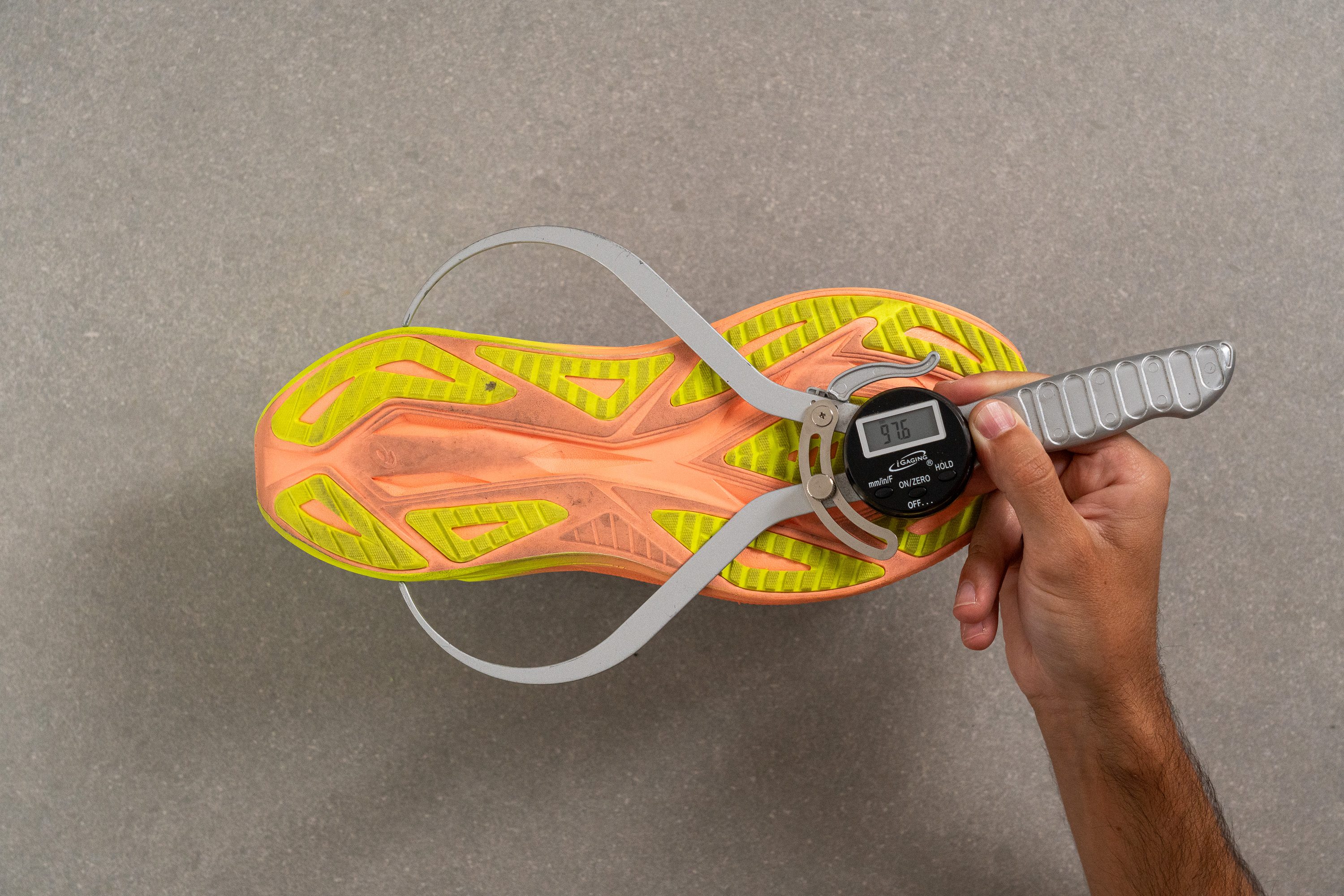
| Superblast 2 | 97.6 mm |
| Average | 90.7 mm |
Durability
Toebox durability
When we examined the upper under the microscope, we were impressed with its durability. And here in our lab, we leave nothing to chance and decided to put it to the ultimate test against our Dremel.
Using the tool at 5K RPM with 3.2N of force, the toebox demonstrated excellent resistance to the sandpaper, scoring a remarkable 4 out of 5—outperforming most running shoes on the market. This test confirms that the shoe is not only more breathable than its predecessor but significantly more durable as well.
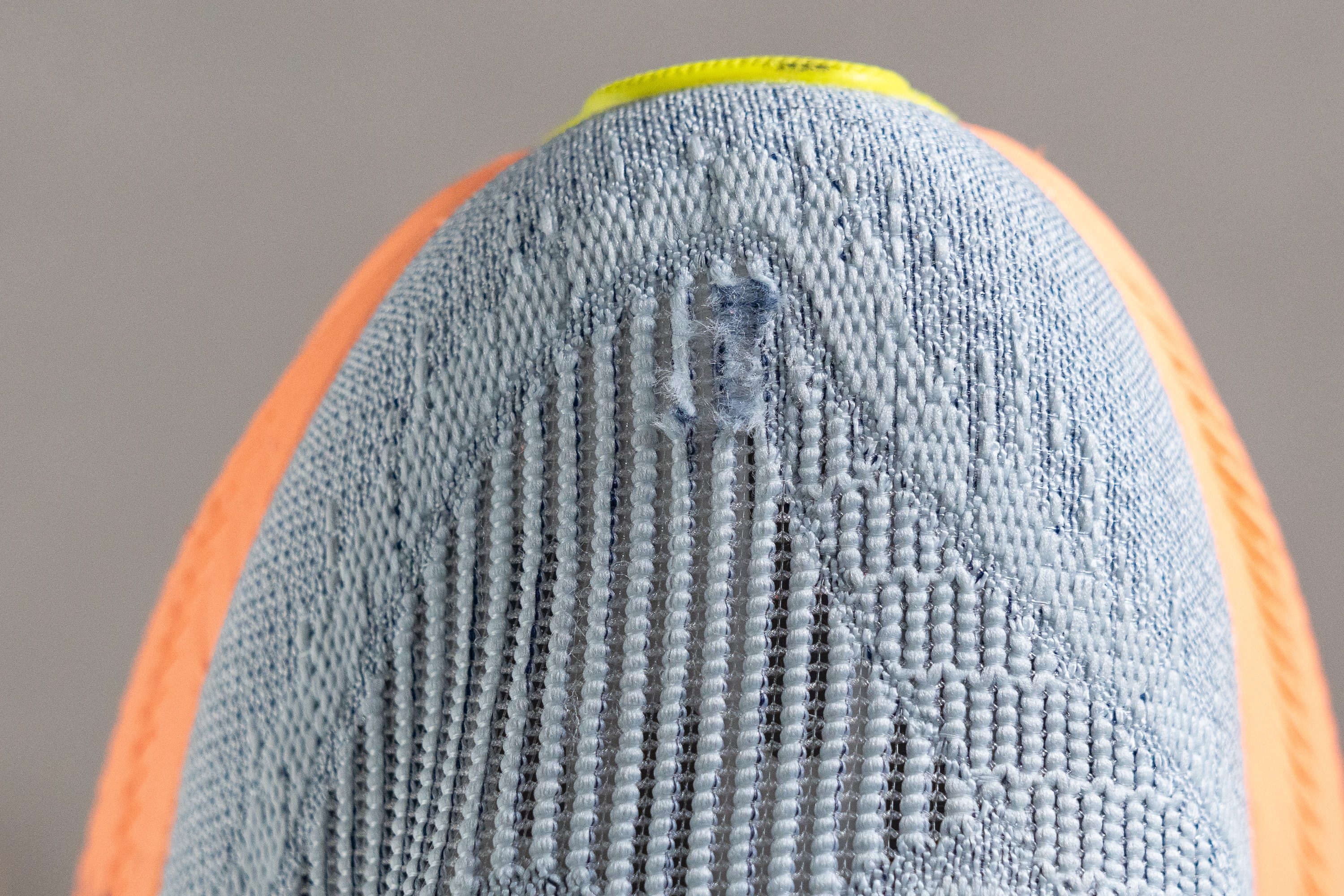
| Superblast 2 | 4 |
| Average | 2.6 |
Heel padding durability
The heel collar area often raises concerns in premium shoes—it would be a significant disappointment if such an investment were compromised there, rather than from normal wear in the outsole or midsole.
Fortunately, our tests with the Dremel tool have put those concerns to rest. We discovered that the heel collar is robust and durable, scoring an impressive 4 out of 5 in our evaluation. This ensures that the shoe stands up well to wear, offering a much needed peace of mind after shelling out £200!
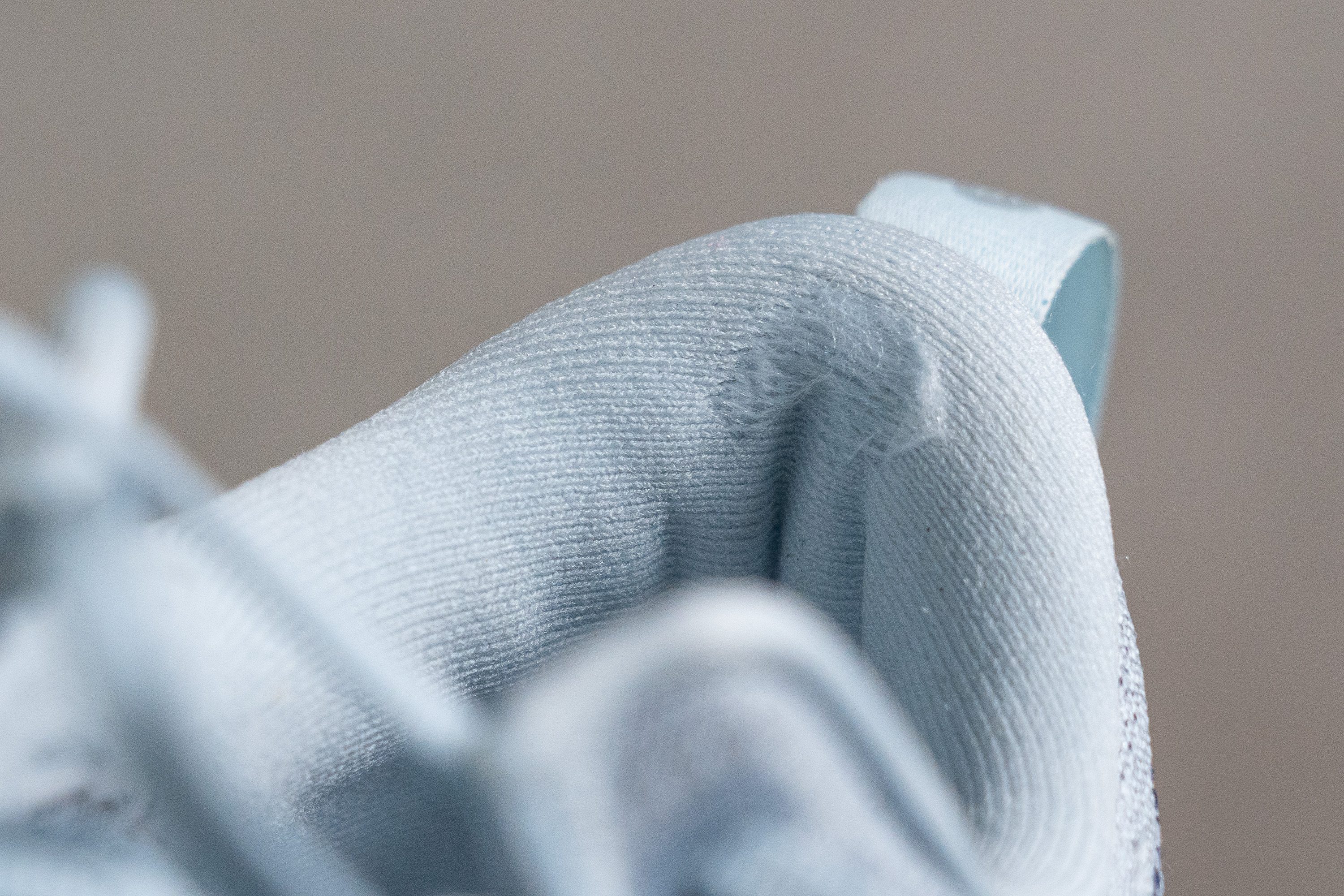
| Superblast 2 | 4 |
| Average | 3.4 |
Outsole hardness
The original Superblast's outsole was often criticised by those who run on dirt roads for being a real pebble-catcher due to its small cutouts. ASICS took note and addressed this issue by eliminating the gaps that trapped stones, much to our satisfaction, and also saving us precious time after every run.

Regarding the outsole, there's another significant upgrade—ASICS switched from their mid-tier AHARPLUS rubber to the softer and grippier ASICSGRIP, boasting a 65.8-HC formulation that enhances traction on all surfaces, rivalling that of racing shoes. Yes, It’s the same rubber used in some ASICS trail shoes like the Trabuco Max 3.
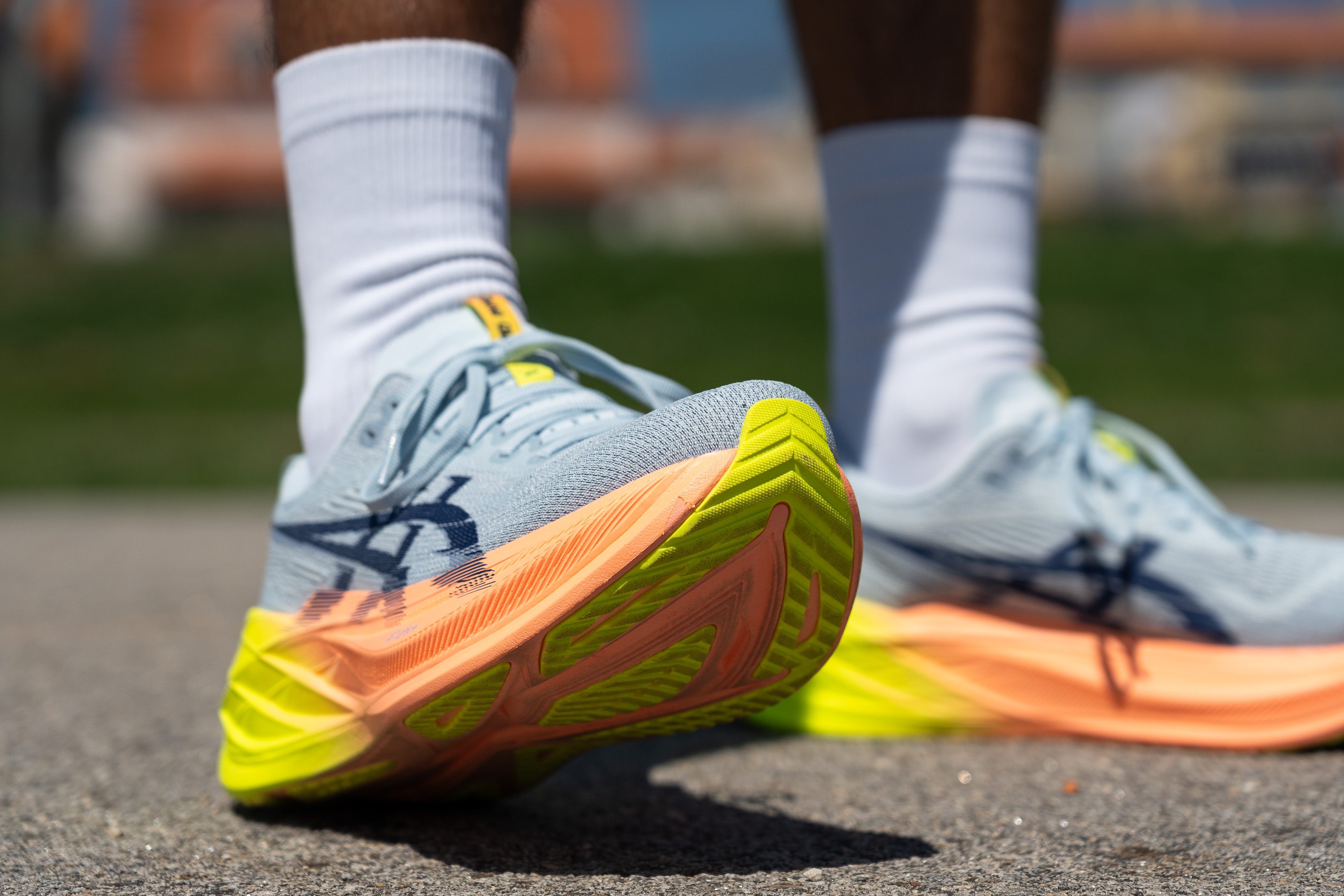
After multiple runs in asphalt and dirt roads, we're excited to report that traction has significantly improved from the previous version in both dry and wet conditions.
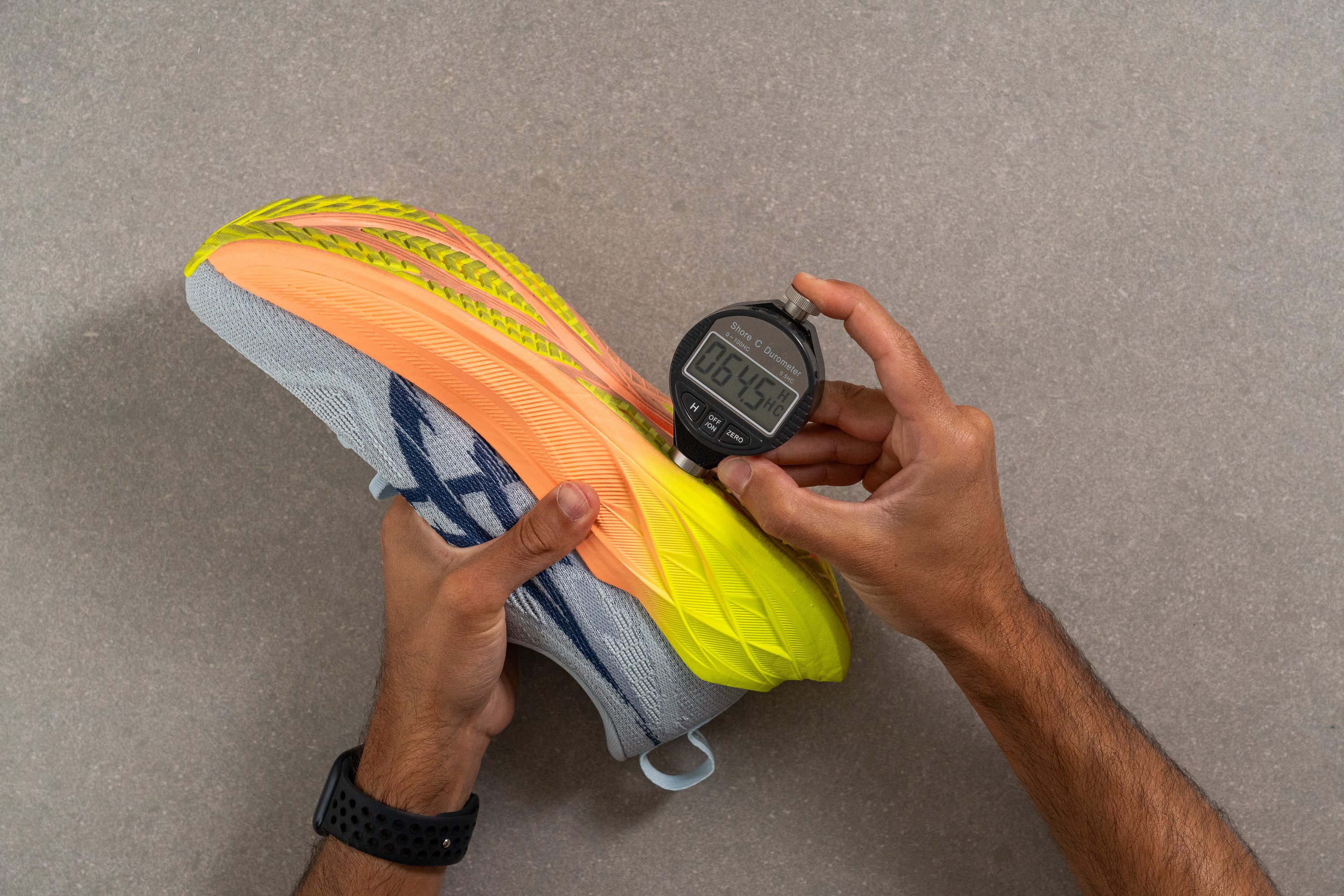
| Superblast 2 | 65.8 HC |
| Average | 79.2 HC |
Outsole durability
Initially, we were sceptical about the durability shift from the original Superblast's resilient outsole—measured at a mere 0.6 mm dent in our lab test—to the softer ASICSGRIP, fearing it might wear down faster.
We cranked up our Dremel to 10K RPM for a rigorous test in the lab. The results were outstanding—a slight 0.5-mm indentation confirmed that the new ASICSGRIP not only maintains durability but might even surpass our expectations for wear resistance.
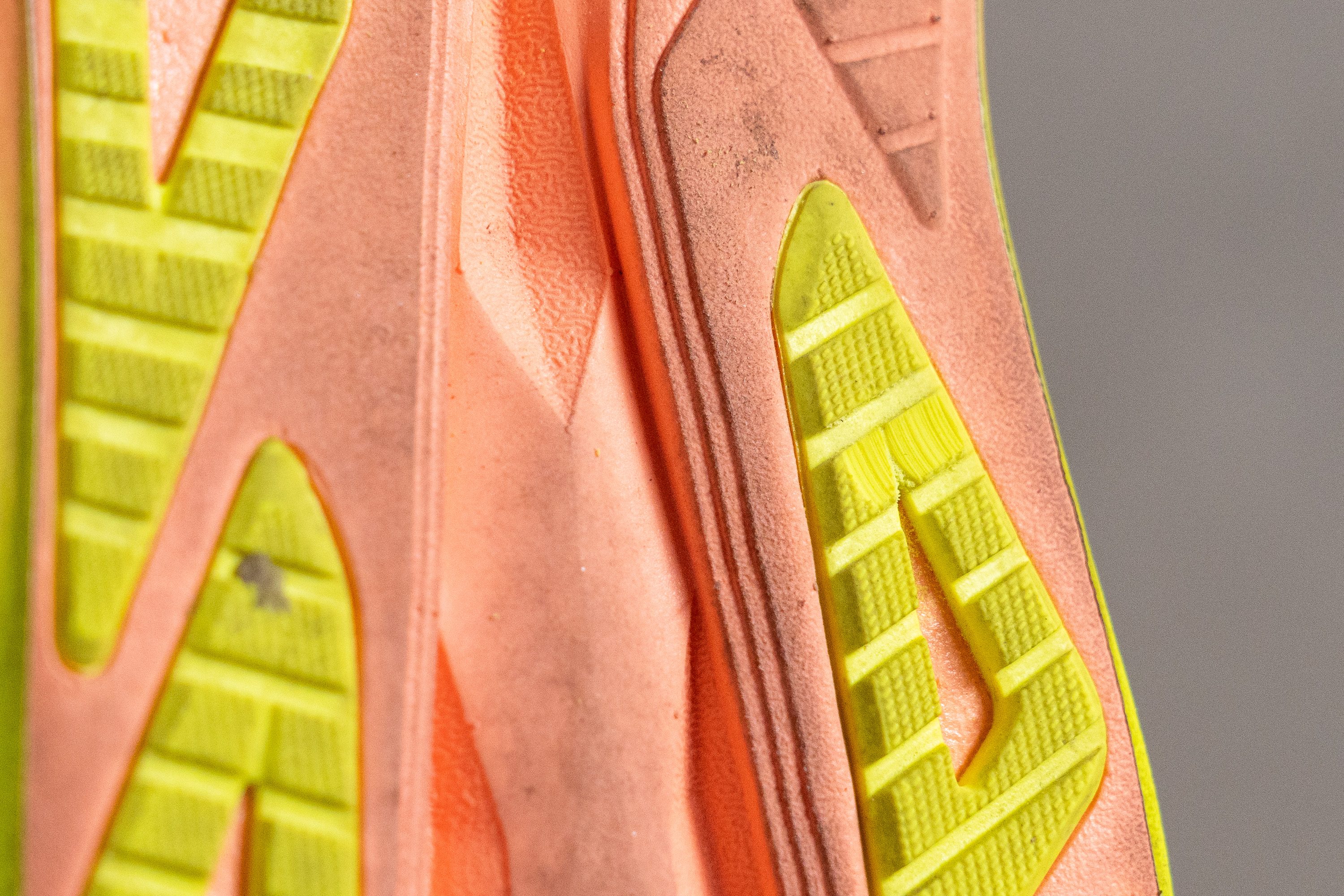
| Superblast 2 | 0.5 mm |
| Average | 1.1 mm |
Outsole thickness
We discovered that ASICS has modestly thickened the outsole from 2.6 mm to 3.1 mm, likely aiming to enhance durability even more. But does this affect the shoe's weight? Let's see...

| Superblast 2 | 3.1 mm |
| Average | 3.2 mm |
Misc
Insole thickness
ASICS opted for a standard insole in the Superblast 2, made of basic EVA and measuring just 4.4 mm in thickness—nothing that stands out as innovative by any means.
For the next version, we see a clear opportunity for improvement: Either a PEBA-based insole crafted from FF Turbo+ for enhanced bounce, or maybe slimming down the insole to allow for additional midsole foam. You choose, ASICS!

| Superblast 2 | 4.4 mm |
| Average | 4.5 mm |
Removable insole
The insole is removable and not glued to the midsole, allowing for easy replacement. We also found it to be fairly standard, so fitting an aftermarket footbed shouldn't be a problem in most cases. However, for two hundred dollars, we would expect a perforated insole to aid in heat dissipation.

| Superblast 2 | Yes |
Midsole softness in cold (%)
In our lab, we put the Superblast 2 through a cold resistance test, chilling it in the freezer for 20 minutes.
The results were quite impressive—the foam only hardened by an insignificant 8.2%, demonstrating minimal impact on softness. However, we were not very surprised as we already knew that PEBA-based foams are praised for maintaining their performance under various temperature conditions.

| Superblast 2 | 8% |
| Average | 24% |
Reflective elements
For a shoe designed to be the ultimate all-rounder for road running, you'd expect it to feature reflective elements for enhanced safety at night.
Indeed, it includes them, and although they're not exceptionally impressive and could be better, at least they fulfil our basic safety requirement.
| Superblast 2 | Yes |
Tongue padding
One of the weaker aspects of the Superblast 2 is its tongue padding, which sees a minimal 0.2 mm increase from its predecessor and remains quite thin for a training shoe at just 1.7 mm. However, it includes two small foam pads that slightly reduce pressure from the laces.

Is the tongue thickness a major issue? It varies. For runners with a sensitive instep who need to tightly secure their laces, this might pose a problem. However, we encountered zero problems during multiple long runs, including 20-milers, using various lacing techniques. Plus considering that more padding would add extra weight, we actually appreciate this slim design for the Superblast 2.

| Superblast 2 | 1.7 mm |
| Average | 5.8 mm |
Tongue: gusset type
The tongue features the same semi-gusseted design as v1—the optimal choice for balancing weight, comfort, and fit. We have nothing but praise for this; it enhances the lockdown effectively without being overpowering in the slightest.

| Superblast 2 | Both sides (semi) |
Heel tab
The heel retains the superb design of the OG Superblast, featuring a finger-loop heel tab that's ideally sized and features exceptionally quality. We are confident in its durability—it doesn’t look like it will tear anytime soon.
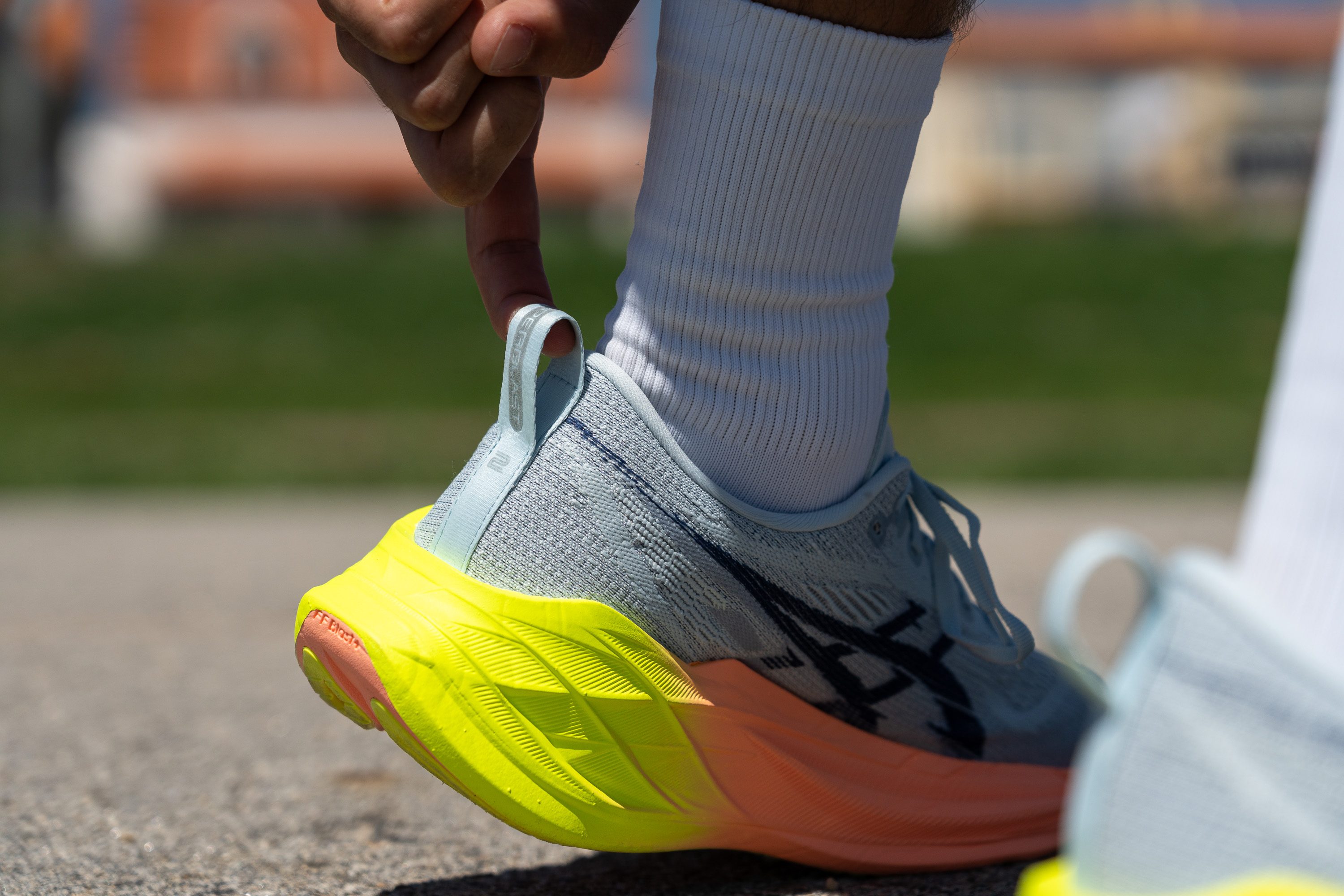
| Superblast 2 | Finger loop |
Build quality
With the Superblast 2, we found the materials to be what you'd expect from a £200 shoe—no issues with messy finishes, excess glue, or paint marks. And an accurate heel-to-toe drop.
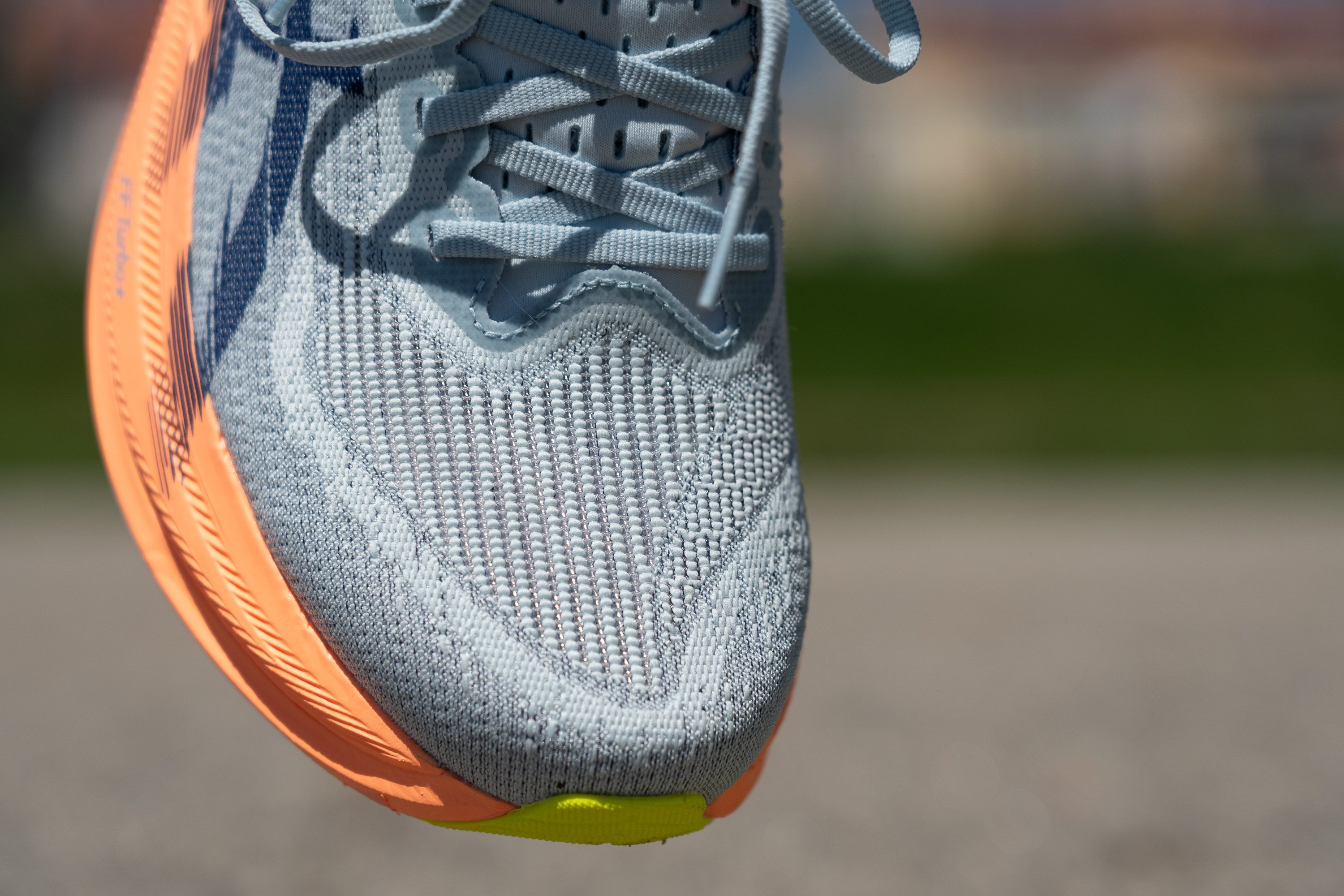
However, we did notice a significant discrepancy in weight between the left and right shoes. The left shoe, our standard for measurements, weighed in at 8.90 oz, while the right was lighter at just 8.55 oz—an unusually large difference that suggests ASICS has room to enhance consistency.

































































